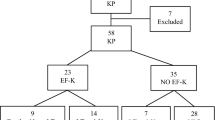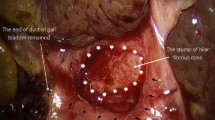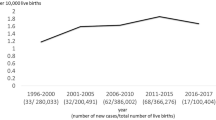Abstract
Purpose of Review
This paper presents an overview of the current developments in the perioperative biliary atresia (BA) treatment.
Recent Findings
Biliary atresia is a rare cholangiopathy and the most common indication for pediatric liver transplantation. Kasai portoenterostomy is the primary therapy, leading to sufficient biliary drainage in 20–30% of patients with native liver. Multiple strategies in preoperative, operative, and postoperative care were tested to improve survival with native liver (SNL). Screening methods, centralization of care to specialized centers, laparoscopic Kasai procedure, and adjuvant steroid therapies are suggested to improve the operative outcomes.
Summary
There is no evident superiority of laparoscopic KPE nor adjuvant steroid therapy. However, screening programs and centralization of care to specialized centers are endorsed.
Similar content being viewed by others
Abbreviations
- BA:
-
Biliary atresia
- BARD:
-
Biliary atresia and related disorders
- ChiLDREN:
-
Childhood Liver Disease Research and Education Network
- ERN:
-
European Reference Networks
- JF-SNL:
-
Jaundice-free survival with native liver
- KPE:
-
Kasai portoenterostomy
- SNL:
-
Survival with native liver
- START:
-
Steroids in Biliary Atresia Randomized Trial
References
Papers of particular interest, published recently, have been highlighted as: • Of importance •• Of major importance
Petersen C, Davenport M. Aetiology of biliary atresia: what is actually known? Orphanet J Rare Dis. 2013;8:128.
Asai A, Miethke A, Bezerra JA. Pathogenesis of biliary atresia: defining biology to understand clinical phenotypes. Nat Rev Gastroenterol Hepatol. 2015;12:342–52.
•• Davenport M, et al. Biliary atresia in England and Wales: results of centralization and new benchmark. J Pediatr Surg. 2011;46:1689–94 This study presents the benefits of centralization of BA treatment in England and Wales for the postoperative outcomes.
•• Chardot C, et al. Improving outcomes of biliary atresia: French national series 1986–2009. J Hepatol. 2013;58:1209–17 This study presents the results of decentralized, institutional collaborations for BA treatment.
de Vries W, et al. Biliary atresia in the Netherlands: outcome of patients diagnosed between 1987 and 2008. J Pediatr. 2012;160:638–644.e2.
Stagg H, et al. Variability of diagnostic approach, surgical technique, and medical management for children with biliary atresia in Canada - is it time for standardization. J Pediatr Surg. 2017;52:802–6.
Davenport M. Adjuvant therapy in biliary atresia: hopelessly optimistic or potential for change? Pediatr Surg Int. 2017;33:1263–73.
Shneider BL, et al. Efficacy of fat-soluble vitamin supplementation in infants with biliary atresia. Pediatrics. 2012;130:e607–14.
Zhang M-Z, Xun P-C, He K, Cai W. Adjuvant steroid treatment following Kasai portoenterostomy and clinical outcomes of biliary atresia patients: an updated meta-analysis. World J Pediatr WJP. 2017;13:20–6.
Lampela H, et al. National centralization of biliary atresia care to an assigned multidisciplinary team provides high-quality outcomes. Scand J Gastroenterol. 2012;47:99–107.
Klemann C, et al. Interleukin 17, produced by γδ T cells, contributes to hepatic inflammation in a mouse model of biliary atresia and is increased in livers of patients. Gastroenterology. 2016;150:229–241.e5.
Petersen C. Biliary atresia: the animal models. Semin Pediatr Surg. 2012;21:185–91.
Petersen C, et al. New aspects in a murine model for extrahepatic biliary atresia. J Pediatr Surg. 1997;32:1190–5.
Nio M, Wada M, Sasaki H, Tanaka H. Effects of age at Kasai portoenterostomy on the surgical outcome: a review of the literature. Surg Today. 2015;45:813–8.
Wildhaber BE, et al. Biliary atresia: Swiss national study, 1994-2004. J Pediatr Gastroenterol Nutr. 2008;46:299–307.
Leonhardt J, et al. Biliary atresia: lessons learned from the voluntary German registry. Eur J Pediatr Surg Off J Austrian Assoc Pediatr Surg Al Z Für Kinderchir. 2011;21:82–7.
• Gu Y-H, et al. Stool color card screening for early detection of biliary atresia and long-term native liver survival: a 19-year cohort study in Japan. J Pediatr. 2015;166:897–902.e1 This study presents the improvement of KPE outcomes after initiation of a nationwide screening program in Japan.
Lien T-H, et al. Effects of the infant stool color card screening program on 5-year outcome of biliary atresia in Taiwan. Hepatolology. 2011;53:202–8.
Chen S-M, et al. Screening for biliary atresia by infant stool color card in Taiwan. Pediatrics. 2006;117:1147–54.
Hsiao C-H, et al. Universal screening for biliary atresia using an infant stool color card in Taiwan. Hepatology. 2008;47:1233–40.
Lin J-S, et al. Reduction of the ages at diagnosis and operation of biliary atresia in Taiwan: a 15-year population-based cohort study. World J Gastroenterol. 2015;21:13080–6.
Wildhaber BE. Screening for biliary atresia: Swiss stool color card. Hepatology. 2011;54:367–8; author reply 369.
Borgeat M, Korff S, Wildhaber BE. Newborn biliary atresia screening with the stool colour card: a questionnaire survey of parents. BMJ Paediatr Open. 2018;2:e000269.
Woolfson JP, et al. Province-wide biliary atresia home screening program in British Columbia: evaluation of first 2 years. J Pediatr Gastroenterol Nutr. 2018;66:845–9.
Schreiber RA, et al. Home-based screening for biliary atresia using infant stool colour cards: a large-scale prospective cohort study and cost-effectiveness analysis. J Med Screen. 2014;21:126–32.
Mogul D, Zhou M, Intihar P, Schwarz K, Frick K. Cost-effective analysis of screening for biliary atresia with the stool color card. J Pediatr Gastroenterol Nutr. 2015;60:91–8.
Kong Y-Y, et al. Modified stool color card with digital images was efficient and feasible for early detection of biliary atresia-a pilot study in Beijing, China. World J Pediatr WJP. 2016;12:415–20.
Hoshino E, et al. An iPhone application using a novel stool color detection algorithm for biliary atresia screening. Pediatr Surg Int. 2017;33:1115–21.
Harpavat S, Garcia-Prats JA, Shneider BL. Newborn bilirubin screening for biliary atresia. N Engl J Med. 2016;375:605–6.
Harpavat S, et al. Newborn direct or conjugated bilirubin measurements as a potential screen for biliary atresia. J Pediatr Gastroenterol Nutr. 2016;62:799–803.
Stringer MD. Biliary atresia: service delivery and outcomes. Semin Pediatr Surg. 2008;17:116–22.
Hukkinen M, et al. Treatment policy and liver histopathology predict biliary atresia outcomes: results after National Centralization and Protocol Biopsies. J Am Coll Surg. 2018;226:46–57.e1.
• Leonhardt J, et al. Biliary atresia: lessons learned from the voluntary German registry. Eur J Pediatr Surg Off J Austrian Assoc Pediatr Surg Al Z Kinderchir. 2011;21:82–7 This study discusses the problems of voluntary registries for rare diseases.
Héon-Klin V. European Reference Networks for rare diseases: what is the conceptual framework? Orphanet J Rare Dis. 2017;12:137.
Morciano C, Laricchiuta P, Taruscio D, Schünemann H. European Reference Networks and guideline development and use: challenges and opportunities. Public Health Genomics. 2015;18:318–20.
Hashimoto T, et al. A modification of hepatic portoenterostomy (Kasai operation) for biliary atresia. J Am Coll Surg. 1997;185:548–53.
Ramachandran P, et al. The extended Kasai portoenterostomy for biliary atresia: a preliminary report. J Indian Assoc Pediatr Surg. 2016;21:66–71.
Wada M, et al. Experience of treating biliary atresia with three types of portoenterostomy at a single institution: extended, modified Kasai, and laparoscopic modified Kasai. Pediatr Surg Int. 2014;30:863–70.
Lishuang M, et al. Laparoscopic portoenterostomy versus open portoenterostomy for the treatment of biliary atresia: a systematic review and meta-analysis of comparative studies. Pediatr Surg Int. 2015;31:261–9.
Hussain MH, Alizai N, Patel B. Outcomes of laparoscopic Kasai portoenterostomy for biliary atresia: a systematic review. J Pediatr Surg. 2017;52:264–7.
•• Ure BM, et al. Survival with the native liver after laparoscopic versus conventional kasai portoenterostomy in infants with biliary atresia: a prospective trial. Ann Surg. 2011;253:826–30 This study presents a rare attempt of a prospective study to investigate the effectivity of laparoscopic Kasai procedure. The study had to be stopped due to the significantly higher rate of liver transplantations in the laparoscopic cohort.
Huang S-Y, Yeh C-M, Chen H-C, Chou C-M. Reconsideration of laparoscopic Kasai operation for biliary atresia. J Laparoendosc Adv Surg Tech A. 2018;28:229–34.
Li Y, et al. Medium-term outcome of laparoscopic Kasai portoenterostomy for biliary atresia with 49 cases. J Pediatr Gastroenterol Nutr. 2018;66:857–60.
Cazares J, et al. Laparoscopic portoenterostomy for biliary atresia: single-center experience and review of literatures. Pediatr Surg Int. 2017;33:1341–54.
Li Z, Ye Y, Wu Z, Wang B. Learning curve analysis of laparoscopic Kasai portoenterostomy. J Laparoendosc Adv Surg Tech A. 2017;27:979–82.
Nakamura H, et al. Does the level of transection of the biliary remnant affect outcome after laparoscopic Kasai portoenterostomy for biliary atresia? J Laparoendosc Adv Surg Tech A. 2017. https://doi.org/10.1089/lap.2016.0202.
Meyers RL, et al. High-dose steroids, ursodeoxycholic acid, and chronic intravenous antibiotics improve bile flow after Kasai procedure in infants with biliary atresia. J Pediatr Surg. 2003;38:406–11.
Stringer MD, Davison SM, Rajwal SR, McClean P. Kasai portoenterostomy: 12-year experience with a novel adjuvant therapy regimen. J Pediatr Surg. 2007;42:1324–8.
Shimadera S, et al. The significance of steroid therapy after hepatoportoenterostomy in infants with biliary atresia. Eur J Pediatr Surg Off J Austrian Assoc Pediatr Surg Al Z Kinderchir. 2007;17:100–3.
Kobayashi H, et al. Optimum prednisolone usage in patients with biliary atresia postportoenterostomy. J Pediatr Surg. 2005;40:327–30.
Escobar MA, et al. Effect of corticosteroid therapy on outcomes in biliary atresia after Kasai portoenterostomy. J Pediatr Surg. 2006;41:99–103; discussion 99–103.
Davenport M, et al. Randomized, double-blind, placebo-controlled trial of corticosteroids after Kasai portoenterostomy for biliary atresia. Hepatology. 2007;46:1821–7.
Davenport M, Parsons C, Tizzard S, Hadzic N. Steroids in biliary atresia: single surgeon, single centre, prospective study. J Hepatol. 2013;59:1054–8.
Petersen C, et al. Postoperative high-dose steroids do not improve mid-term survival with native liver in biliary atresia. Am J Gastroenterol. 2008;103:712–9.
Vejchapipat P, Passakonnirin R, Sookpotarom P, Chittmittrapap S, Poovorawan Y. High-dose steroids do not improve early outcome in biliary atresia. J Pediatr Surg. 2007;42:2102–5.
Chung HY, Kak Yuen Wong K, Cheun Leung Lan L, Kwong Hang Tam P. Evaluation of a standardized protocol in the use of steroids after Kasai operation. Pediatr Surg Int. 2008;24:1001–4.
Sarkhy A, Schreiber RA, Milner RA, Barker CC. Does adjuvant steroid therapy post-Kasai portoenterostomy improve outcome of biliary atresia? Systematic review and meta-analysis. Can J Gastroenterol J Can Gastroenterol. 2011;25:440–4.
Zhang D, et al. Postoperative steroids after Kasai portoenterostomy for biliary atresia: a meta-analysis. Int J Surg Lond Engl. 2014;12:1203–9.
Japanese Biliary Atresia Society, Nio M, Muraji T. Multicenter randomized trial of postoperative corticosteroid therapy for biliary atresia. Pediatr Surg Int. 2013;29:1091–5.
•• Bezerra JA, et al. Use of corticosteroids after hepatoportoenterostomy for bile drainage in infants with biliary atresia: the START randomized clinical trial. JAMA. 2014;311:1750–9 The authors in this study investigated the effect of adjuvant corticosteroids following Kasai procedure on the postoperative outcome in a prospective, randomized trial, showing no significant benefits of treatment.
Goodhue C, Fenlon M, Wang KS. Newborn screening for biliary atresia in the United States. Pediatr Surg Int. 2017;33:1315–8.
Redkar R, et al. Outcome of biliary atresia after Kasai’s portoenterostomy: a 15-year experience. Indian Pediatr. 2017;54:291–4.
Nio M, Wada M, Sasaki H, Tanaka H, Watanabe T. Long-term outcomes of biliary atresia with splenic malformation. J Pediatr Surg. 2015;50:2124–7.
Ng VL, et al. Medical status of 219 children with biliary atresia surviving long-term with their native livers: results from a North American multicenter consortium. J Pediatr. 2014;165:539–546.e2.
Chan KWE, et al. Laparoscopic versus open Kasai portoenterostomy in infant with biliary atresia: a retrospective review on the 5-year native liver survival. Pediatr Surg Int. 2012;28:1109–13.
Author information
Authors and Affiliations
Corresponding author
Ethics declarations
Conflict of Interest
The authors declare that they have no conflict of interest.
Human and Animal Rights and Informed Consent
This article does not contain any studies with human or animal subjects performed by any of the authors.
Additional information
This article is part of the Topical Collection on Pathobiology of Orphan Diseases
Rights and permissions
About this article
Cite this article
Madadi-Sanjani, O., Petersen, C. Perioperative Developments in Biliary Atresia Treatment. Curr Pathobiol Rep 6, 241–246 (2018). https://doi.org/10.1007/s40139-018-0181-y
Published:
Issue Date:
DOI: https://doi.org/10.1007/s40139-018-0181-y




